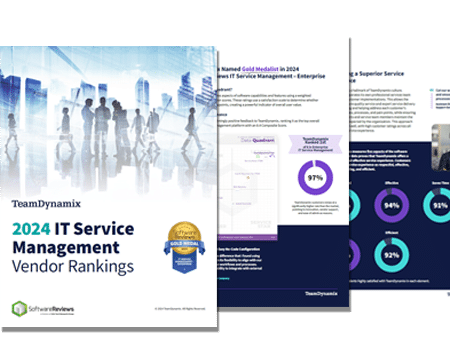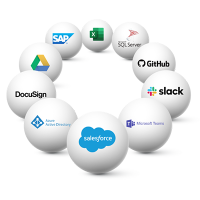
Understanding Change Management and Its Importance Within Your Organization
Did you know that a significant number of IT incidents occur when someone makes a change to one system that then affects other systems in

The Info-Tech ranking report offers a unique view of the market based entirely on in-depth customer interviews. Download the Info-Tech ITSM Quadrant and Customer Viewpoint report today.

We’ll show you some of our best situations and show you exactly how to execute them to get immediate results. The best part is, iPaaS tools often feature easy-to-use click and drag functionality, meaning you don’t need a dedicated employee building integrations and workflows.

System Integrators, Value Added Resellers, Technology Providers, and Buying Consortiums can benefit from a partnership with TeamDynamix.

The Info-Tech ranking report offers a unique view of the market based entirely on in-depth customer interviews. Download the Info-Tech ITSM Quadrant and Customer Viewpoint report to gain a better understanding of key vendor strengths and emerging market requirements.
If you are working within an IT Service Management team, you have probably sat in many meetings where you are discussing how can we drive self-service portal adoption? You may have put up posters, sent out emails, tracked usage, redirected inbound service requests – and yet, you are not there – but why? Some teams are looking deeper and incorporating human-centered design to help drive IT self-service portal adoption.
Human-Centered Design (HCD) is a design and management framework that involves the human perspective in all steps of the problem-solving process. It’s about making products, systems, and services more usable, and thus more effective, by focusing on the needs, desires, and limitations of the end user.
In human-centered design, it’s important to drop any preconceived notions you might have about users and their needs. Instead, you learn about users’ needs and challenges by observing and talking with them. Rather than having a specific outcome in mind, human-centered design calls for keeping your mind open to various possible solutions.
This approach is one many organizations use when implementing self-service portals as part of their IT Service Management (ITSM) and Enterprise Service Management (ESM) strategies.
Implementing HCD requires empathy, a deep understanding of your users, and a willingness to iterate your solutions based on real-world feedback. But when done right, it can result in a more efficient, effective, and satisfying experience for all users.
Human-centered design is based a few fundamental principles that are applicable to the implementation of an IT service portal within an organization. They are as follows:
Once you understand the principles, you can start the design process. To do this, you should follow the three phases that make up human-centered design:
In the context of self-service portals and IT Service Management, HCD can bring several improvements:
User-Friendly Interface: HCD helps create an intuitive and easy-to-navigate interface. By understanding user behaviors, preferences and needs, designers can develop a portal that’s not only functional but also enjoyable to use. This can increase user engagement and satisfaction.
Efficient Problem-Solving: HCD can aid in presenting solutions to common problems or frequently asked questions in an easily accessible way. This reduces the need for users to contact support, freeing up resources for the IT department.
Improved Accessibility: HCD promotes accessibility, ensuring that the self-service portal is usable by people with varying abilities. This includes designing for different devices, browsers and screen sizes, as well as considering users with disabilities.
Feedback Mechanisms: Incorporating feedback mechanisms allows users to communicate their issues or suggestions. This data can then be used to continuously improve and adapt the service to meet evolving needs.
Personalization: Understanding users on a deeper level can allow for personalized experiences. For instance, the portal could suggest relevant articles or solutions based on a user’s past behavior or role within the organization.
Increased Adoption: A well-designed portal, built with the user at the heart, is more likely to be adopted by users. This can lead to increased self-service usage, reducing the load on the IT service desk.
At Grand Rapids Community College Kelley Webber, a support desk coordinator, saw the value in implementing a human-centered design approach to the college’s ITSM strategy. Establishing an IT service portal was supposed to make life easier for tech support staff because they wouldn’t have to spend as much time on the phone trying to understand the nature of users’ issues. However, Webber and her team found that fewer than 5 percent of support tickets were being initiated through the service portal, while 60 percent still originated through phone calls. They set out to redesign the service portal and service catalog to make it more user-centric so that more stakeholders would engage with it.
Employ a Focus Group
To do this, they shook up the format of the focus groups. “We had users sit down at a computer, and we watched them interact with our IT service catalog to see their reactions,” Webber says. “We realized many users didn’t understand the verbiage or icons we were using.”
For instance, the service portal had a category for “Telephony Services,” but most students didn’t understand this term. “They thought it was a made-up word,” Webber says. The newly redesigned portal will use the service catalog category “Campus Phones and Conferencing Services” instead.
Using User-Focused Vernacular
What’s more, end-users didn’t know they should choose the service category “Software Requests” if they had a problem with their mobile campus app, because they didn’t realize apps and software were the same things. “We had an old-school mentality that it was all just software,” Webber says. The redesigned portal will change the name of this service category to “Apps and Software” to make this clearer to users.
But the biggest lesson to come out of the focus groups was a reminder of why it’s important not to make assumptions. Webber and her team thought that simply redesigning the service portal would lead to greater use — yet they learned many students weren’t aware of its existence. “We never stopped to think whether students even knew how to get to it,” she acknowledges.
To read more about Grand Rapids Community College’s experience designing a user-friendly service portal, check out: Human-Centered Design Helps Grand Rapids Community College Engage with IT Users More Effectively.
With a well-designed portal in place, utilizing human-centered design, the next step is to build out your knowledge base. A knowledge base is a method of self-service that gives users the power to solve their own problems. It houses articles that contain documentation of common issues and provides solutions.
Knowledge bases are an incredibly valuable resource when thoughtfully created and managed well. Here are just a few benefits of having a knowledge base as part of your service portal:
As with human-centered design, building a knowledge base has its own methodologies – the most successful being Knowledge-Centered Service® (KCS). KCS is a methodology that provides businesses with a strategy to best solve problems through an abundance of available knowledge. The clear structure and framework of KCS allows for feedback and helps organizations to publish information more accurately.
Implementing Knowledge-Centered Service can involve a lot of moving parts. The following are six steps to help you get started:
Learn more about knowledge bases and TeamDynamix here.
This article was originally posted in February 2021 and has been updated with new information.

Did you know that a significant number of IT incidents occur when someone makes a change to one system that then affects other systems in

The construction industry can be very volatile, with a high employee turnover rate due to seasonal fluctuations in the workforce. A key challenge for the

A study from Information Week and TeamDynamix shows companies are looking to invest in IT Service Management (ITSM) software that is simple to administer and
TeamDynamix’s award-winning SaaS cloud solution offers IT Service and Project Management together on one platform with enterprise integration and automation.
[email protected]
(877) 752-6196
Contact Us
